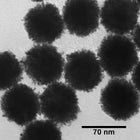Colloidal platinum nanoparticles are useful in a diverse range of applications including catalysis, drug delivery, cancer detection, sensing, materials science, and more. At nanoComposix, our standard products include an easily displaceable citrate capping agent for integration into a variety of uses. All catalog formulations are extensively washed for the removal of residual reagents, but for in-vivo & in-vitro research applications where purity is a high priority, try BioPure Platinum with a guaranteed endotoxin limit of < 2.5 EU/mL (< 5 EU/mL for ≤ 20 nm sizes).
Don’t see the size or surface you need? Contact us to find out more about custom platinum nanoparticle options.
Synthesis & Physical Properties
At nanoComposix, platinum nanoparticles are synthesized by reducing platinum salt precursors in solution in the presence of a capping agent to generate colloidal nanoparticle suspensions. Control over the size of platinum nanoparticles can be achieved by changing the platinum salt precursor, by altering the ratio of ligand to precursor, and/or by adjusting the reaction temperature. Sizes can be customized, but standard offerings include 5 nm, 30 nm, 50 nm, and 70 nm options.
Generally platinum nanoparticles appear brown in color at low to medium concentrations. Highly concentrated suspensions appear very dark brown or nearly black in some cases.

Above: Transmission Electron Microscope (TEM) image of 70 nm platinum nanoparticles produced by nanoComposix.

Above: Transmission Electron Microscope (TEM) image of 70 nm platinum nanoparticles produced by nanoComposix.

above: 0.05 mg/mL by Pt mass

Above: 1 mg/mL by Pt mass
Optical Properties
The interesting optical properties exhibited by platinum nanoparticles are largely dominated by a surface plasmon resonance in the ultraviolet region of the electromagnetic spectrum. These signatures are uniquely positioned at higher energy (lower wavelength) than other common plasmonic nanoparticles including silver and gold. These unique characteristics make these materials useful for a range of industrial uses and novel applications.

nanoComposix Platinum Nanoparticles Featured in Literature
The selected articles below highlight the use of platinum nanoparticles made by nanoComposix in fuel cell technologies, cancer therapies, and catalysis:
- Ram P. Lamsal, Aaron Hineman, Chady Stephan, Sadaf Tahmasebi, Stève Baranton, Christophe Coutanceau, Gregory Jerkiewicz, Diane Beauchemin, Characterization of platinum nanoparticles for fuel cell applications by single particle inductively coupled plasma mass spectrometry, Analytica Chimica Acta, Volume 1139, 2020, Pages 36-41
- Xin Chang, Christopher Batchelor-McAuley, Richard G. Compton, Methanol oxidation at single platinum nanoparticles, Journal of Electroanalytical Chemistry, Volume 896, 2021, 115438
- Aswad, D. S., & Qoqaj, I. (2018), Platinum nanoparticles in photothermal therapy of cancer cells, UCPH NanoScience - a Student Research Journal
- Wenmiao Yu, Christopher Batchelor-McAuley, Xin Chang, Neil P. Young, and Richard G. Compton, Porosity controls the catalytic activity of platinum nanoparticles, Phys. Chem. Chem. Phys., 2019, 21, 20415-20421

